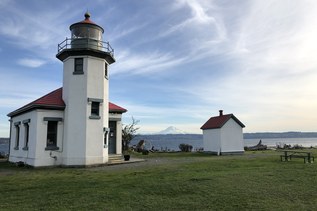In 1909, a majority of the park’s current 70 acres were donated by the Cornwall family in honor of industrialist and philanthropist Pierre Barlow Cornwall. In its early years, the park was a popular car camping destination. Though no longer open to overnight visitors, the park is still a popular day-use destination. From trails to playgrounds, and from disc golf to multiple sports courts, there is no shortage of recreation opportunities at Cornwall Park.
A series of interconnected trails wind their way through the park passing open fields, forested areas and Squalicum Creek. Most of the trails that encircle the park are paved, wide and wheelchair-friendly. The trails themselves are unnamed and, while there are trail maps posted at a few key locations in the park, the trail junctions are unsigned. Despite the lack of signs, there are plenty of landmarks to keep you oriented. You can choose your own adventure and connect the trails in any way you like, but please take care to stay on the trail to protect the sensitive vegetation.
Depending on the time of year, the park’s trails are perfect for dodging the winter snow at higher elevations, watching for blooming magnolias in the spring, looking for abundant mushrooms in the fall or escaping the summer heat by cooling off in the shade of the forest canopy.
Extending your hike
After visiting Cornwall Park, if you’re itching to get more miles under your belt, consider adding on a stop at other nearby parks — Sunset Pond, Squalicum Creek and Elizabeth Park are good options.






 Trailhead
Trailhead





